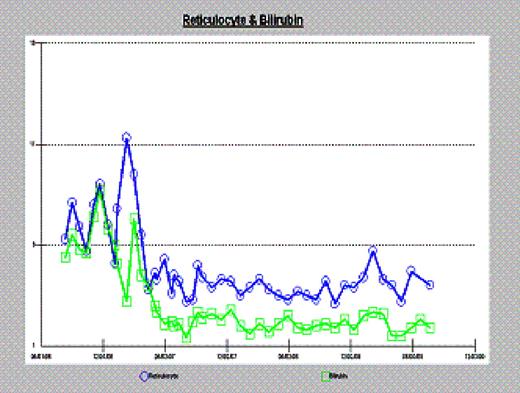Abstract
Abstract 4620
Transfusions have clearly been shown to prevent stroke in patients with Sickle Cell Disease(SCD). The usual goal of transfusion therapy is to keep the percent sickle Hgb (%S) less than 30. %S greater than 30 has been associated with stroke reoccurance. Inability to transfuse adequately may result from poor vascular access or high hemolytic rate. Hydroxyurea, a drug which requires active erythropoeisis, is usually not given to patients who are chronically transfused. However, the presence of an elevated reticulocyte count in a transfused patient indicates ongoing sickle hematopoiesis. We added Hydroxyurea therapy to two patients who were unable to achieve %S levels less than 30 and who had elevated reticulocyte counts to assess whether this drug could improve their hematological parameters.
We treated two post stroke patients, one receiving pheresis therapy, and the other on straight transfusion therapy who were unable to achieve 30% Hgb S despite regular transfusions. Patient 1, a 33 y/o female with Hgb SS had been on transfusions since childhood for multiple CVA's and resulting moya-moya. Her last stroke had occurred while she was being chronically transfused and had a % S of 40. Due to venous access issues the patient was receiving straight transfusion only and was unable to adequately suppress her marrow. In 8/07 her %S was greater than 40 and her reticulocyte count was 11.3 %. Hydroxyurea was started at 1500 mg daily(22 mg/kg). Over the next 24 months her Bilirubin dropped from 8.7mg/dl to 1.9 mg/dl, her reticulocyte count dropped to 4%(figure below) and her MCV increased to 104.6 from 90. Her Hgb F rose to 30%.Her %S has not changed. She has remained clinically stable with no new neurological findings. The second patient, a 17 y/o male had been on chronic transfusions since childhood for a stroke which resulted in a dense left hemiparesis. He has been on a pheresis program for 13 years. Despite this his % S remained greater than 40% and had been as high as 60% prepheresis. Hydroxyurea was added in 5/08 at a dose of 25mg/kg. Within 6 months his pretransfusion %S had dropped to 22-27%. No increase in fetal Hgb was detected, possibly due to the exchange transfusion process. His bilirubin, which had been running between 12-16 mg/dl dropped to 7.6-8.9 mg/dl and his reticulocyte count went from an average of 19.6% to 11.2% in the same time frame. He has also remained stable.
These two patients demonstrate that the addition of Hydroxyurea to patients on chronic transfusion can be useful in decreasing hemolytic rate and improving the efficacy of transfusions by decreasing sickle erythropoiesis and increasing fetal hemoglobin synthesis. Further studies of the combination of these two modalities may be warranted in those patients who cannot achieve adequate suppression of sickle erythropoeisis.
Patient 1-top line, retic count; bottom line bilirubin(8/06-8/09)
Patient 1-top line, retic count; bottom line bilirubin(8/06-8/09)
No relevant conflicts of interest to declare.
Asterisk with author names denotes non-ASH members.


This feature is available to Subscribers Only
Sign In or Create an Account Close Modal